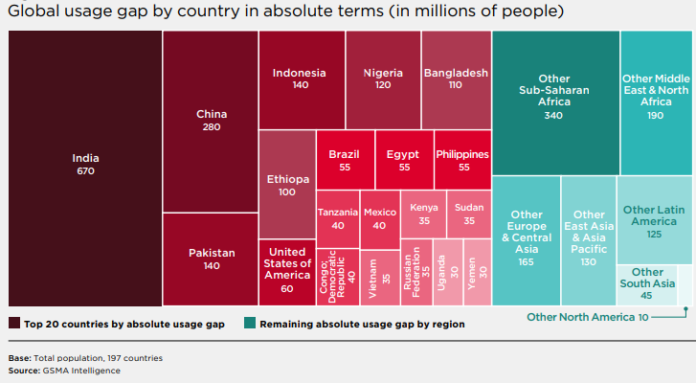GSMA, the global organization of mobile network operators, has said that about 120 million Nigerians lacked access to mobile internet by the end of 2023, creating a huge usage gap for the country.
The agency announced this in the just-released ‘State of Mobile Connectivity Report 2024’. It described the usage gap as the population living within the footprint of a mobile broadband network but not using mobile internet.
Globally, GSMA said around 3.45 billion people, or 43% of the world’s population, still did not have access to mobile internet at the end of last year.
“The least connected region in the world is Sub-Saharan Africa, where only 27% of the population uses mobile internet services, leaving a coverage gap of 13% and a usage gap of 60%,” GSMA said.
Barriers to entry
The report notes that for the unconnected people in low- and middle-income countries (LMICs), including Nigeria, affordability of devices and digital skills and literacy are the key barriers to mobile internet adoption.
“In these countries, entry-level internet-enabled devices cost 18% of the average monthly income, while for the world’s poorest 20% this rises to 51%.
“In Sub-Saharan Africa, which accounts for a quarter of the world’s unconnected population, this rises to 99% of the average monthly income for the region’s poorest 20%,” the report said.D.
- The report further identified a lack of digital skills and literacy as the second biggest barrier overall, but the most important issue in the Asian countries surveyed in the new report.
- The other established barriers to people using mobile internet are a lack of relevant, localized content and services, concerns about safety and security, and limited access to additional critical infrastructure and services such as electricity.
Enabling meaningful connectivity
The report notes that while the majority of people who use mobile internet do so on a daily basis, this typically only applies to a relatively small number of the most popular use cases, adding that on average 43% of mobile internet users in the countries surveyed indicated that they wanted to use it more.
“Among those already using mobile internet, the most commonly reported barriers to increased use include safety and security concerns, affordability (particularly of data but also handsets) and the connectivity experience,” GSMA said in the report.
- It added that while the vast majority of people worldwide now access the internet via a 4G or 5G smartphone, one in five mobile internet subscribers still use 3G smartphones or a feature phone.
- This reaches more than a third in Latin America and the Caribbean and MENA and almost two-thirds in Sub-Saharan Africa, limiting the reach and depth of online and digital experiences among users.
Bridging the gap
Commenting on the study’s findings, John Giusti, Chief Regulatory Officer at the GSMA, said that while progress is being made in improving infrastructure and increasing mobile internet adoption, significant digital gaps exist.
“Furthermore, while most users use mobile internet on a daily basis, their activities are often limited to just one or two activities, even though many have expressed a desire to do more.
“This highlights persistent barriers – affordability, lack of skills and literacy, safety and security concerns and a lack of relevant content and services – that prevent users from getting online and then using mobile internet to meet their livelihoods once they be online.
“Governments, mobile operators and international organizations must work together to tackle barriers such as affordability, digital skills and awareness of mobile internet and the benefits it can bring.
“This commitment must also focus on investing in local, digitalnumerous ecosystems and ensuring robust online security frameworks,” he said.
What you need to know
According to data from the Nigerian Communications Commission (NCC), mobile internet subscriptions in Nigeria stood at 163.3 million as of December 2023.
During the same period, the number of actively connected mobile lines reached 224 million, indicating that approximately 61 million of the connected lines were not used to access the Internet.









